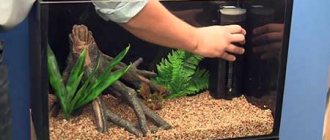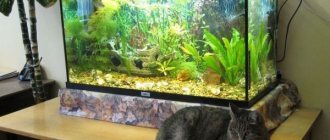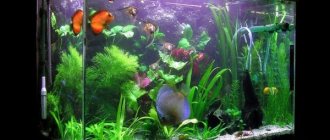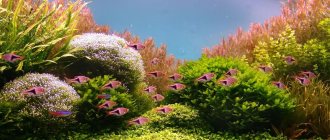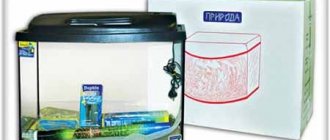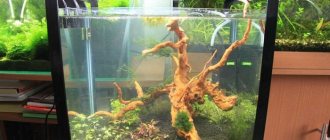When choosing an artificial reservoir, the aquarist first faces the question of its volume. In large containers it is easier to maintain bio-equilibrium, but there is not always enough space in the room for a large tank. Therefore, aquarists often opt for a 30-liter aquarium. Such a volume requires the creation of a suitable design, selection of appropriate equipment, plants and inhabitants.
Choosing an aquarium
Beginning aquarists often wonder what shape of vessel to choose. The size of the 30-liter aquarium and the area it will occupy in the room depend on the configuration.
The classic option is rectangular tanks. They are easy to maintain and convenient for monitoring the inhabitants. Cube containers offer the same benefits but take up less space. Round vessels are not the best option for keeping fish. It is difficult to place the necessary equipment in them and maintain cleanliness, and the convex glass distorts the shape, making it difficult to observe aquatic organisms.
Aquarium equipment, small introduction
So let's look at this issue today. Today, there is a clear understanding of how a modern aquarium should be equipped and equipped, and it seems that a novice aquarist should not have any problems with choosing aquarium equipment. A huge number of all kinds of technical equipment and devices are offered by stores selling aquarium equipment for every taste and budget, it would seem that choose what you like best and you will not know grief with your home pond.
But everything is not as simple as it might seem at first glance. Let's go in order. No offense to some aquarists, especially beginners. There is such a point: how do many people decide to purchase an aquarium and the necessary equipment? That's right spontaneously. We decided to buy an aquarium, and at the same time, what else do we need? A heating pad to keep the fish warm. Oxygen for breathing. Do you need a filter? Well, let's have some kind, inexpensive, so that there is one. Then, at the market or in a store, they listened to the seller and collected all this equipment, buying soil, plants, and sometimes fish at the same time, and with the feeling that everything was done correctly, go home and create your own aquatic world.
If you follow this scheme, in the best case, you will be left with an unpleasant aftertaste and will have to redo everything all over again, and in the worst case, the desire to work on an aquarium will disappear forever. But everything can be done differently. Choose exactly what is needed for the inhabitants you plan to keep, and a healthy and prosperous aquarium will delight you for many years.
Decor
Setting up a 30 liter aquarium may seem difficult due to the small area of the bottom of the vessel. However, even in such a small volume you can create an original aquatic design that attracts the attention of the observer. A background depicting the underwater world will help to visually increase the volume of the tank. Decorations are installed in the corners of the container and along the back wall. When creating the design of a 30-liter aquarium, small driftwood and stones, as well as artificial objects, are used.
Aquarium equipment - CO2 (carbon dioxide) supply system
As mentioned above, for the good growth of aquarium plants, especially demanding species, the presence of carbon dioxide is required. Which plants use to build their tissues. For these purposes, systems for supplying CO2 to the aquarium are produced.
The CO2 system consists of a gas cylinder, a reducer, a valve, a gas sprayer (there are different designs) and hoses. Depending on the volume of the aquarium, a suitable system is selected. The volume of a gas cylinder can be from 100 grams to 5 liters (sometimes more).
CO2 system
CO2 supply system to the aquarium
Such installations are used in combination with strong lighting and the supply of various fertilizers to the aquarium. Only in this case will the use of such equipment be justified and give positive results. In ordinary and simple aquariums, the use of a CO2 system will be unjustified; unpretentious plant species grow well without its use.
Necessary equipment
For the normal functioning of a 30-liter aquarium, you need equipment that creates comfortable conditions for fish and plants. In a thirty-liter reservoir you should place:
- Heater with thermostat. It allows you to maintain the water temperature at a given level. The built-in thermostat automatically turns the device on and off. Place the heater near the bottom in a corner or along the back wall of the aquarium.
- Thermometer. It allows you to monitor changes in water temperature. Aquarium thermometers come in glass and liquid crystal. The first are placed inside the reservoir, the second are glued to the glass outside.
- Lighting. Fluorescent or LED lamps are used for lighting. Incandescent lamps are not used, because they heat up the water very much. The lamp must be protected from splashing water.
- Compressor. It supplies air inside the aquarium through a hose with a sprayer. Thanks to this, the water is mixed and saturated with oxygen. It is recommended to place the compressor on a separate stand to protect aquarium inhabitants from vibration.
- Filter. It traps dirt particles and neutralizes harmful compounds dissolved in water due to the bacteria living in it. The filter can be external or internal. For a small aquarium, an internal filter with a power of 25-40 W is suitable. A more powerful device will create a strong current in a 30-liter aquarium, which is not suitable for all types of aquatic organisms and plants.
On a note! An economical option for equipment is to use an internal filter with an aeration function instead of a conventional filter and compressor.
Aquarium equipment - filter
Therefore, filters come first on the list of equipment we need and, accordingly, water filtration is of utmost importance for the aquarium population. Filters can be divided into several categories. Internal and external There is also such a thing as a phytofilter, but we will not focus on it in this article. You can read the link to the article about the phytofilter.
Internal filters
They have a simple design, essentially a plastic container with filler and a pump. With the help of which water is pumped and thereby filtered through a filler (various sponges, less often a ceramic filler or a combination of these materials).
Internal filter
Internal filter
Internal filter
Internal filters are designed, as a rule, for small or medium-sized aquariums from 20 liters to 150-200 liters, sometimes used in large aquariums as an additional filter.
External filter
The same container (canister) with filler and pump, only taken outside the aquarium. As a rule, it is used for large-volume aquariums of 150 liters or more. It has a much larger volume of filter media and, accordingly, can process a larger amount of harmful substances formed in the aquarium during the life of the inhabitants.
External filter
External filter disassembled
You can read more about external filters and the importance of filtering water in an aquarium in this article.
Plants
For a 30-liter aquarium, you should choose medium-sized, slow-growing plants. The most popular and unpretentious types suitable for this volume include:
- Cryptocoryne. This plant is a bush of 5-15 leaves on petioles. He is placed in the background. The plant requires: weekly water changes, illumination 0.4-0.5 W/l, water temperature 24-28°C, acidity pH 6.5-7.4.
- Java moss. The plant has the appearance of a low-growing bush, covered with a large number of small leaves. Java moss is undemanding in terms of lighting and water parameters. The plant is suitable for decorating driftwood, stones and backgrounds: fixed to the surface with a fishing line or thread, the moss quickly takes root and covers the entire area provided to it with an even layer.
- Riccia. This is a plant floating on the surface of the water, consisting of thin stems collected in rosettes. Riccia grows well at temperatures of 20-30°C, bright light and weekly water changes. Riccia loves stagnant water, so there should be no intense current in the aquarium.
- Elodea. This is a long-stemmed plant with small leaves. It requires a temperature between 14-18°C and good lighting. Elodea grows quickly, so it needs to be pruned regularly.
- Hornwort. This is a plant with a long stem and thin leaves collected in whorls. Hornwort feels good at temperatures of 17-28°C, dH 6-15° and pH 7-7.5. It is recommended to periodically trim and thin out the plant.
Aquarium equipment - heater (heater)
The presence of a heater or just a heating pad in the aquarium is necessary if you plan to keep heat-loving species of tropical fish. For cold-water species that are sometimes kept in an aquarium, in particular domestic species, for example, crucian carp, perch, stickleback, carp and others, a heater is not needed; rather, the issue will arise with cooling the water rather than heating it.
Aquarium heater
Fish from the tropics, of course, need a heating pad. Comfortable temperature for these types of fish is in the range of 24-26, 27 degrees C, in some cases 28-30 or higher degrees C (for example, for discus).
Modern heating pads are equipped with a temperature sensor, which means that by setting the aquarium to 25 degrees C. The heater will heat the water to this value, and then go into maintenance mode, constantly turning on and off.
Please note that in some models of heating pads, the temperature scale and sensor may give different values from the real ones. For example, you set it to 25 degrees C, and the heating pad heated the water to 27 degrees, so the temperature of the water in the aquarium must be monitored using a thermometer.
Choosing the necessary heater for an aquarium is not difficult. Manufacturers of aquarium equipment indicate the volume of a particular heating pad. You can roughly estimate that a 100-liter aquarium will require a 100-watt heater.
Video Heater for aquarium AQUAEL 25 W. review and test
What fish are suitable for a 30 liter aquarium?
Some experienced aquarists are of the opinion that small artificial reservoirs are not intended for keeping fish. In fact, it is possible to have aquarium fish in a 30-liter aquarium, but when selecting species, it is necessary to take into account their size, behavioral characteristics and compatibility with each other. Typically, beginning aquarists choose the following types:
- Goldfish. When getting representatives of this popular species, you should remember that goldfish require a lot of space; Only 1 individual can be kept in a 30-liter tank. Goldfish quickly pollute water, so the aquarium must be equipped with a powerful filter and aeration system. Recommended water parameters: temperature no more than 18-23°C, dH 8-25°, pH 6-8.
- Barbs. These are schooling fish, which are recommended to be kept in numbers of at least 5-10 individuals. Barbs are very active, so the aquarium must be covered with a lid to prevent the fish from jumping out of the water. For keeping barbs, water with a temperature of 20-25°C, dH 4-10° and pH 6.5-7.5 is suitable. Fish with veil fins and long mustaches (angelfish, gourami, goldfish) should not be placed in an aquarium with barbs, because barbs can damage them.
- Gourami. In a 30-liter volume you can keep a couple of small species of gourami (dwarf, honey gourami) or 1 individual of a larger species. The aquarium must be closed with a lid. Recommended water parameters: temperature 25-28°C, pH 6-6.8, dH no more than 10°. The volume should be equipped with a filter that does not create a strong current, and planted with plants in which the fish can hide.
- Mollies. These are small fish that are recommended to be kept in groups. It is possible to keep it together with other peaceful species. Suitable water parameters: temperature 24-27°C, dH 11-25°, pH 7.5-8. The aquarium must be covered and planted; it is necessary to install a filter and an aeration system.
- Danio. These small fish are well suited for a 30 liter capacity; they should be kept in a flock. Danios live in the upper layers of water, so the aquarium must be covered with a lid. Slow-sinking feed is used for feeding. Recommended water parameters: temperature 18-25°C, dH no more than 20°, pH 6-7. It is possible to keep them together with non-aggressive species of suitable size.
- Sword bearers. A 30-liter aquarium can contain several individuals of this species. Recommended water parameters: temperature 22-26°C, dH 10-25°, pH 7-8. The reservoir must be covered with a lid, planted with plants and equipped with a filtration and aeration system.
- Cardinals. These small fish should be kept in a school. The water temperature must be maintained at 18-22°C, pH 6-8.5. Cardinals are well compatible with other small peaceful fish species (neons, guppies, zebrafish).
- Neons. A large group of these small, bright fish can be placed in a 30-liter aquarium. The volume should be densely planted with plants and equipped with shelters. Lighting is required diffused, water temperature 24-26°C, pH 5.5-8, dH 5-20°. Neons can be kept together with other small non-aggressive species.
- Catfish corridors. A volume of 30 liters can contain a couple of fish of this species. Corydoras are bottom dwellers that dig the substrate, so the soil particles should be of medium fraction and not have sharp corners. This is a crepuscular species, so lighting should be diffused. You should install more shelters in the aquarium, under which the catfish will rest during the day, and plant plants.
- Guppy. These are small, bright fish that can be kept in schools. Recommended water parameters: temperature 22-25°C, dH more than 10°, pH 6-7.5. Plants should be planted in the aquarium and a filtration system should be installed. It is possible to keep guppies together with other small peaceful species.
Which filter should you choose? Price, quality, manufacturer
In fact. If we now describe all existing filter models, their advantages and disadvantages, and also analyze the cost of this or that model in various aquarium stores, it will probably turn out to be a whole book in terms of the number of pages, not inferior to the book “War and Peace”.
Therefore, I have this suggestion: if you have problems choosing a filter for your aquarium, write in the comments under the article, in the VK group or by email, I will try to help you and tell you which filter model will be more acceptable in your case. Just don’t forget to indicate the volume of your aquarium and who you plan to populate it with.
If we consider external filters in general, there are branded models on the market such as: EHEIM (Germany) are one of the most famous manufacturers and, accordingly, expensive. Next, JBL (Germany) are more affordable, but also very high quality and reliable. JBL has a very successful line of filters, the CristalProfi greenline series. FLUVAL (Canada).
Then come AQUAEL (Poland). TETRAtek (Germany-China) are more affordable. However, this does not mean that they do not perform their functions; both work perfectly.
Next are various Chinese brands. Among which there are external filters that are very affordable and decent in terms of quality. For example, such as ATMAN, JEBO are good devices for reasonable money.
When buying a filter, be guided by the volume of the aquarium, plus take with a small reserve, this never hurts. For example, for a 200-liter aquarium, it makes sense to take a filter designed for a 300-liter aquarium.
Then look at the money. If finances allow, take famous manufacturers. Money is tight, then look at filters from the middle price segment or Chinese brands. They cope with their main task of purifying water in an aquarium, regardless of the brand.
Starting an aquarium
Launching an aquarium begins with laying the soil and placing decorations. Then pre-settled water is poured into the container and left for several days. After 1-2 days the water will become cloudy; this is a sign of bacterial growth. A couple of days after becoming cloudy, the water will regain transparency; at this time, equipment is installed (filter, compressor, heater and thermometer). After this, the aquarium is left for a week. Then the plants are planted and the lighting is turned on. After 1-2 days, the fish are stocked.
Is it possible to make an aquarium without any equipment at all?
It would seem that the question is, to put it mildly, inappropriate. How is this possible without equipment? How can this be? In fact, an aquarium can be organized without the help of various technical means, here is an article about one of the options for such an aquarium.
By and large, a completely full-fledged aquarium can be organized even in an ordinary liter jar, don’t believe me? Then look here. The only point is that you must maintain a clear balance between the inhabitants in such an aquarium. There should be a large number of living plants and a small number of fish, shrimp and other inhabitants. But in most cases this type of aquarium is not suitable due to the fact that you want to place a larger number of the same fish in the aquarium than the aquarium’s biosystem can handle without additional help.
Care
Caring for the aquarium after starting is easy. Standard care includes cleaning the soil, changing water, cleaning walls and washing equipment. For the first time, they must be carried out a month after launch, and then weekly. The soil is cleaned of accumulated silt using a siphon. The glass is cleaned with a scraper, removing plaque and algae. The equipment is washed from dirt and deposits in water drained from the aquarium. 20-30% of the volume is replaced with clean, settled water.
The 30 liter aquarium is suitable for both beginners and experienced aquarists. If you follow the rules of care in such a tank, it is not difficult to maintain bio-equilibrium. A 30-liter vessel does not take up much space and at the same time makes it possible to create an interesting design, plant exotic plants and stock fish and other aquatic organisms. If you liked the article or have something to add, leave your comments.
Tips and important nuances
Maintaining and caring for a home aquarium, its proper organization are important processes on which the comfortable existence of pets and the aesthetic microclimate of the room depend. To create these correct conditions, in order to avoid problems and mistakes, you need to follow simple tips for novice aquarists.
Installation location and choice of aquarium
The first stage concerns the choice of an aquarium. Before purchasing a house for aquatic inhabitants, it is necessary to determine its future location. The aquarium in the house should fit organically into the interior, have a wide viewing angle and a convenient approach for further use. Be in a place where the sun's rays will not disturb its surface, stand steadily.
Some models are equipped with special stands or have legs; they can be placed on the wall with the help of fasteners and occupy corner space. By design, there are three types:
- Frame products have a metal frame.
- All-glass ones have no joints or seams.
- Frameless - structures without frames and screws, glued together from glass or plexiglass.
The volume and dimensions of the tank depend on the number, size and type of aquatic pets. If there is no clear understanding yet of who will live in the aquarium, approximate calculations suggest that there is 1 cm of fish per 1 liter of water. For example, if the total length of the inhabitants is 12 cm, then the holding capacity must be at least 120 liters. Tanks with a volume of more than 100 liters imply the presence of a closed ecosystem, which will require less maintenance effort.
The pet store offers a wide selection of different forms of aquariums:
- spherical models;
- cube-shaped;
- rectangular;
- panoramic with convex glass;
- polygonal.
The optimal solution for teapots is a spacious tank with a classic rectangular shape. Moreover, its length should be greater than its height. A voluminous aquarium of the correct configuration will allow you to create a stable bacterial environment, contain a large number of fish, and take care of it without much difficulty.
The tank is installed on a smooth, level surface. There must be a soft layer between the body of the container and the area of the object on which it is installed. The edges of the aquarium should not protrude, so as not to deform and burst under the weight of the weight of water.
Necessary equipment
It is recommended to equip the first aquarium with a standard set of necessary equipment.
- Filters purify water to avoid stagnation. They are of two types: external and internal. The first is installed to filter water in spacious tanks. A small aquarium is maintained using an internal filter. They must be washed with water from the aquarium so as not to disturb the water balance inside the device. The filter material is changed every six months.
- An aerator is a device for supplying water with oxygen, which must operate around the clock (the filter may have the function of water aeration).
- A thermometer will allow you to control the temperature of the water, which will save your fish from many diseases.
- Temperature control equipment. This could be a water heater for winter and a refrigeration unit for hot weather. For novice owners, it is better to choose devices with automatic temperature control.
- Lighting devices are necessary to maintain the normal growth of not only fish, but also plants, which will allow you to recreate the natural habitat as much as possible. The power of the lamp will depend on the specific species of pets and algae.
Among the auxiliary materials you need to have a siphon for cleaning the soil, a scraper for cleaning the walls of the vessel from algae and plaque, a special feeder and a net.
Important! An obligatory component of the aquarium is a lid, which will serve as the basis for attaching the lamp, will reduce water evaporation and prevent fish from jumping out.
If desired, cabinets or stands for storing food and necessary accessories can be purchased separately. When all the components have been purchased, we proceed to installing the aquarium. Assembly must be done on a flat surface.
Water quality
The basics of aquarium keeping are focused on testing water with special tests, with the help of which its composition and quality are determined. They are purchased at a pet store. The instructions contain precise operating information.
Before filling the container with water, it must first be prepared. It should sit for 24 hours. Do not contain impurities of chlorine and other elements. It is allowed to add special conditioners to water to improve water quality. If the liquid is too soft, more shells and pebbles are added. Hard water needs to be boiled.
Decor
A home aquarium is created taking into account the creation of a colorful landscape. This is facilitated by a variety of shelters, grottoes and decorations. The presence of snags will help the fry to hide from voracious adults.
Experts in the field of aquarium farming advise beginners to use basalt soil or rounded medium-fraction gravel. A bottom made of small particles is more difficult to clean from food debris and waste products. Its optimal thickness is from 4 to 7 cm. You can accurately determine the required layer based on the characteristics of the plants you need.
Creating comfortable conditions for fish and plants
The duration of lighting per day should not exceed 12 hours. With longer work, plant growth will increase, and the life cycle of fish, on the contrary, will decrease. During the first 2 weeks, the lighting is turned on for 6–8 hours.
The water temperature for the comfortable existence of most aquatic inhabitants is 22–26°C. Depending on the specific type of inhabitants, the degree scale can range from 18–23°C for people from northern latitudes and rise to 33°C for animals and plants in tropical zones.
The water in the aquarium is replaced with clean, settled water partially every week. It is prohibited to change it in full. There is no need to change the water in the first month. The amount of new liquid in a fish aquarium should not exceed 25–30% of the total volume.
Fish
Beginner aquarists are advised to opt for unpretentious specimens:
- guppy;
- petiliah;
- mollies;
- swordtails.
They are characterized by similar behavioral norms, consume a variety of food and are quite peaceful and not picky about changes in the quality and condition of water.
Guppy.
Pecilia. Mollies. Sword bearer.
You can get cardinal fish, fire barbs and zebrafish, which, if properly kept, can live up to 3 years. Catfish will help clean the bottom surface from settling food and clean off organic growth from the walls.
The main rule is not to have a large number of pets at the same time, but to observe whether everything is done correctly. To start with, you should start with no more than 8 fish in an aquarium from scratch.
Plants
Ease of care and maintenance is what a novice breeder needs for an aquarium. A large number of aquatic flora meet similar criteria:
- pinnate;
- hornwort;
- Vallisneria;
- elodea;
- Riccia floating.
They are not picky about temperature and water quality and require minimal illumination.
Before planting in the ground, plants purchased in the store must be treated with a solution of water with 3% hydrogen peroxide. Vegetation from natural bodies of water cannot be introduced into the aquarium. As the plant grows, it is necessary to trim it to prevent the appearance of foreign plaque.
Snails
At least two weeks must pass before starting the aquarium. After 7 days, the hardiest pets are allowed to be planted - ampullaria snails and unpretentious plants, which contribute to the faster development of the ecosystem. Based on how they feel, it’s easy to determine whether your simple aquarium is ready to accept the next batch of residents.
Aquarium care
Depending on the number of fish, the volume of the tank and the condition of the water, it is necessary to care for the aquarium at least once every 1–2 weeks. During maintenance, you need to siphon the bottom, paying attention to each area, change at least 20% of the water, clean the walls of the aquarium from plaque and algae, and wash all filter elements from contaminants.
Auxiliary equipment and accessories for the aquarium
Now let's talk about the basic auxiliary tools that are required to care for the aquarium.
Thermometer or thermometer
Necessary for monitoring the water temperature in the aquarium.
Electronic thermometer for aquarium
Please note that thermometers may show the wrong temperature, so you need to check it and compare the readings in an aquarium where the temperature is indicated correctly. I came across thermometers from some manufacturers where from a batch of 30 pcs. the discrepancies in the data were 8 degrees.
Net
Here I think everything is clear, there is no need to explain why it is needed, the only point is that it is advisable to have a couple of nets of different sizes.
Fish net
Siphon for aquarium
A very necessary device for caring for an aquarium; a couple of months after the launch of a new aquarium, it will be very useful to you. How to siphon soil and why you need it, read this article.
Siphon for aquarium
Scraper
Necessary for removing unwanted algae and dirt from aquarium glass. There are a lot of companies that produce this useful device for every taste and budget.
Scraper
Scraper
This is the minimum set you should complete based on the volume of the aquarium and the needs of its future inhabitants. If you have any questions, don’t hesitate to ask them in the comments or group, I’ll be happy to try to help you figure it out.
That's all. All the best, don’t forget to subscribe to the news of the aquarist’s blog on social networks, as well as the channel on Youtube - because lately I’ve been trying to post there, in my opinion, very interesting videos. Good luck to you and your aquarium pets.
Aquariums, cabinets - Aquariums up to 30 liters Round
Where to buy fish aquariums?
You can buy branded aquariums in the 24PET.ru catalog of different shapes and displacements, as well as the necessary accessories from the brands AA, Aquatlantis, EHEIM, Ferplast, Hagen, Tetra and others.
Kinds
Aquariums can be decorative, special and professional. The first type is used for decorative purposes. They come in various shapes: rectangular, square, cylindrical, etc. Special ones are used for specific tasks - raising fry, young animals, fish reproduction. In sediment tanks (small-volume reservoirs) the inhabitants of the aquatic world are quarantined or for the purpose of treatment.
There are also aquariums used for professional purposes for breeding fish and growing plants. Basically, these are volumetric models equipped with specialized equipment.
Aquariums can be ready-made, those offered on our website from different companies, or custom-made. The official manufacturer of the finished aquarium is responsible and provides a guarantee for the products of his company.
Types
Ready-made aquariums are presented in different types of structures:
- frame models;
- frameless types;
- seamless solutions.
Frame technology is the most common. Such an aquarium will serve you well for decades if you follow the operating rules. In particular, it must always be filled with water. This technology is mainly used for the production of large-sized products, since they must be significantly stronger than small-capacity tanks.
The frameless design is used for the production of small and medium-sized containers. Organic glass is used as the main material. Usually people decide to buy such aquariums because of their interesting shape, but their service life does not let them down. For example, these include spherical models. Silicate or organic glass is used for production.
Aquarium cabinets
Our store also offers special cabinets used as a stand. Basically, they are made of chipboard and coated with moisture-resistant varnish. In addition, the upper part of most models comes with rounded solid edges without seams. For aquariums from a manufacturer of a certain company, it is better to choose original cabinets, which are usually created in the same style as the tank. But the most important requirement for them is not design, but stability, so that you don’t have to worry about the safety of the aquarium and its inhabitants.
It is worth noting the equipment that must be present in any aquarium - this is a lighting unit and a filter. Branded aquariums are often equipped with this equipment, and you do not have to purchase it separately. The section of the site with branded equipment for aquariums is here.
It is recommended to buy aquarium stands and aquariums at the same time. The manufacturer of the product is the buyer’s choice. More detailed information about the use of products can be found on the official website of the manufacturer.
Our online store offers branded aquariums; the official website 24pet.ru allows you to buy a wide range of products for fish.

